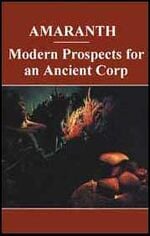Production[edit | edit source]
PLANTING
Amaranths are usually seeded directly into the field. On rare occasion, vegetable amaranths are transplanted to the field as seedlings when they reach the stage of bearing four true leaves. Seeding density depends on the method of harvest anticipated. Preliminary density trials indicate that' for many Amaranthus hypochondriacus and Amaranthus cruentus cultivars, 320,000 plants per hectare is an acceptable density for yield as well as for stand management. Vegetable amaranths are often grown with densities up to 100 plants per m2.
Seedbeds should be of good filth, well drained, and fairly level to help prevent rain from washing away the tiny seeds or seedlings. Seeds must be planted no more than I cm deep, and the seedbeds must have fine soil without large clods. Rain falling on this type of seedbed can cause the soil to form a crust that inhibits germination.
CULTIVATION
Once the stand is established, maintenance is relatively easy. The broad leaves and erect habit quickly create a closed canopy, making understory weeds only a minor problem under most conditions.
Grain amaranths can be mechanically weeded until the canopy closes. Most types of grain amaranth mature in 4-5 months. They mature more quickly in monsoonal areas. However, in some highland regions maturing may take as long as 10 months.
HARVESTING
A few varieties selected in Pennsylvania are now sufficiently uniform to be machine harvested, but most are not. The main difficulty in mechanical harvesting is that the central flower head matures and dries out while the numerous inflorescences on lower side branches are still moist. High-density planting modifies plant structure to a point where a single seedhead is formed, and this makes mechanical harvest more efficient. Selection and breeding of new varieties that are adapted to mechanical harvest is now in progress. To avoid the problem of nonuniform maturity the grain amaranth now produced in Latin
America and South Asia is hand harvested. It is then dried in the sun and threshed and winnowed by hand. The small seed size makes cleaning awkward. However, winnowing is not too difficult, since the seed is heavier than the chaff.
PESTS
Insect problems are not well documented. In Pennsylvania the lygus bug (Lygus lineolaris) has severely damaged grain amaranth yields by piercing the developing seed and sucking out the juices. Amaranthus cruentus (white-seeded types) seem more susceptible to damage than Amaranthus hypochondriacus. Leaf-miners have also been found on both grain and vegetable amaranth. In Lucknow, India, serious damage to both grain and vegetable types has often been caused by spider mites. In India the stem weevil (Lixus truncatulus) is a major pest of amaranth; its grubs damage foliage and roots and cause the plants to wilt. Leaf rotters (Hymenia recurvalis) also cause considerable damage during rainy seasons.
Seedbeds should be guarded against ants and termites, which often carry away all the seeds.
DISEASES
More study is needed of diseases on both vegetable- and grain-type amaranths. The soil fungus Alternaria alternantherae causes much leaf damage and drastically reduces plant vigor. However, only Amaranthus caudatus has so far proved susceptible to this disease in Pennsylvania. A similar blight disease of leaves and flowers, caused by Alternaria amaranthi (Peck.), has been reported on Amaranthus hypochondriacus in India. White rust, caused by Albiyo bliti, in which white pustules on the underside of the leaves reduce the market appeal of vegetable amaranth, is also common in South India.
There is evidence that a foliar disease (or perhaps air pollution) affects Amaranthus cruentus in the United States. Leaf and stem diseases caused by mycoplasms have been identified in Peru, and great differences in susceptibility between lines have been noted.
